Understanding ink use-by dates
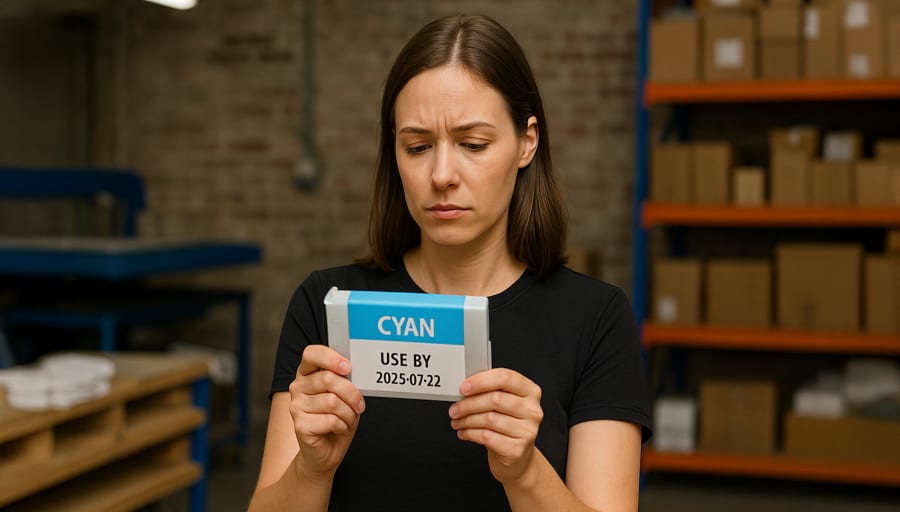
SYDNEY, Australia - August 25, 2025
In this article, we’ll explain why ink expiry dates matter, how the supply chain affects ink freshness, what happens if you use ink past its date, and how different types of inks (like UV, DTF, dye sublimation, and especially white inks) have varying shelf lives.
Ink use-by dates (or expiration dates) are more than just a suggestion, they are a crucial guideline from manufacturers to ensure you get the best performance and avoid problems. We often get asked questions such as, “Is ink still good after the expiration date?”, “How do you check ink expiry dates?”, “How do you know if ink has gone bad?”, and “Why do inks expire?”.
Whether you’re a beginner or a pro using GJS supported printers (Roland DG, Epson, Brother, Sawgrass, Coltex, ROQ), this guide will help you avoid costly mistakes and keep your printer running smoothly.
Understanding ink expiry dates and why they exist
An ink cartridge’s expiry date is the date set by the manufacturer to indicate how long the ink is expected to perform as intended. In other words, it’s the period during which all the ink’s chemical components will flow correctly through your printer’s tubes, filters, and printheads, and the ink will print with the proper colour and quality.
Beyond that date, the manufacturer no longer guarantees the ink’s performance. This doesn’t mean the ink will suddenly dry up or become unusable at midnight of the expiration day, but it does mean you take on risk by continuing to use it.
Why do inks expire in the first place? There are several important reasons:
- Chemical stability: Over time, ink formulations can separate or break down. For example, solvents or water in the ink can slowly evaporate or the pigments can settle and coagulate. A once-smooth ink can become thicker or sludgy, which may clog fine nozzles in your printhead. In water-based inks, there’s even a risk that microbes could grow once preservatives wear off, leading to sediment or slime in the cartridge. Manufacturers determine an expiration date to ensure the ink’s ingredients remain stable and mixed as intended up to that time.
- Print quality assurance: Expired ink can produce unpredictable results. Colours may shift or print with dull, faded output if some pigments have settled or chemically changed. You might suddenly see prints with incorrect hues, banding, or reduced sharpness because the ink is not jetting or curing the way it should. The expiry date is a conservative cutoff to help you avoid these quality issues in your important projects.
- Preventing damage: Perhaps most critically, using ink past its prime can cause physical damage to your printer. Ingredients in the ink (like resins or pigments) that have started to separate can build up inside the printhead and ink lines. Given enough build-up, nozzles can clog permanently and filters or pumps may fail. For instance, expired ink that has thickened might not flow properly, leading to dried ink inside the system. One direct consequence could be printhead failure if the ink hardens or clogs inside it. In extreme cases, users have reported that old ink, particularly some UV-curable inks, can even solidify and cause components like cartridges to burst or lines to block. These scenarios are nightmares for any printer owner.
Manufacturers account for typical storage conditions and worst-case scenarios when setting an expiration date. It’s a “best before” date to protect you and your equipment. Up to that date, they are confident the ink will perform as advertised. After that, all bets are off, and importantly, the warranty on your printer likely won’t cover damage caused by expired ink.
In fact, most printer manufacturers explicitly state that using expired ink can void your warranty. They consider it user neglect if a failure is traced back to out-of-date ink. We’ll discuss warranty implications more in a moment, but keep this in mind: adhering to ink use-by dates is part of proper printer maintenance and care.
The supply chain: How ink gets to you (and why time matters)
It’s important to realise that the clock on an ink cartridge’s shelf life starts from the date of manufacture, not from when you purchase it. By the time an ink reaches your hands in Australia, a significant chunk of that shelf life may have already elapsed due to the supply chain timeline.
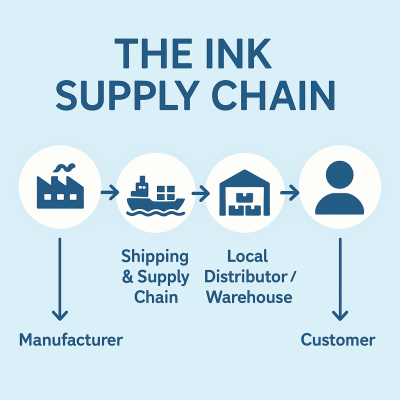 Manufacturing, overseas shipping, customs clearance, and local distribution all take time. For example, one major manufacturer notes that due to shipping times and logistics, inks arriving in the Australian market will always have less than their full listed shelf life remaining.
Manufacturing, overseas shipping, customs clearance, and local distribution all take time. For example, one major manufacturer notes that due to shipping times and logistics, inks arriving in the Australian market will always have less than their full listed shelf life remaining.
In their case, the ink formula might have a 12-month life from manufacture, but by the time it’s on a dealer’s shelf in Australia, it could be several months old. This illustrates that some of the “freshness window” is used up before you ever break the seal.
At GJS, we manage our inventory carefully to provide customers with inks that have the longest possible remaining life. However, it’s wise for you as a user to check the dates when you receive new ink and plan your usage accordingly. Don’t stash new cartridges away for years – use the FIFO (First In, First Out) approach: use your oldest (but unexpired) stock first, and keep newer stock as backup.
If you know a certain ink colour or type is rarely used in your workflow, avoid over-ordering it far in advance. It’s better to order on an as-needed basis rather than to find out an expensive ink cartridge expired in storage before you ever opened it.
Ink chemistry and shelf life: not all inks are created equal
Different printing technologies use different ink chemistries, which means their shelf lives and behaviour over time can vary. Here’s a breakdown of how various ink types (commonly used in the printers GJS sells) hold up and what special care they might need:
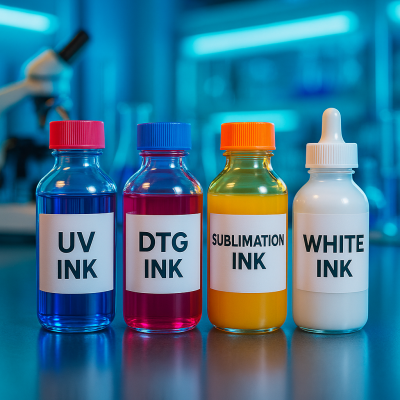 DTF/DTG pigment inks: water-based pigment inks (used in DTF and DTG printers) are relatively stable, but white ink is the exception (see below). Shelf life can be between 12–18 months.
DTF/DTG pigment inks: water-based pigment inks (used in DTF and DTG printers) are relatively stable, but white ink is the exception (see below). Shelf life can be between 12–18 months.- Dye sublimation inks: these water-based inks can last about 6–12 months. While sealed cartridges are fairly stable, once opened, exposure to air can degrade the dyes. Expired sublimation ink often leads to faded colours or uneven results, especially on textiles and hard substrates.
- UV inks: UV-curable inks typically have the shortest shelf life as they contain reactive components that can harden over time, especially if not stored correctly. As such, Epson and Roland will only guarantee a minimum shelf life of two months on UV inks when they're ordered locally due to the supply chain points above. Expired UV ink can cause clogs or even partial curing inside cartridges or lines, so rotation and use within date are essential.
- White ink (general): Used across UV, DTF, and DTF/DTG systems, white ink is the most volatile. Due to dense pigment loads, it settles quickly and spoils easily. Always shake it, use it quickly, and never let it sit idle. This ink type is the most likely to clog or cause damage when expired.
The key takeaway is that different inks have different vulnerabilities: UV inks can chemically cure and harden, sublimation inks can lose potency or clog with dyes, pigment inks can settle (especially white), etc. Always refer to the guidelines for your specific printer’s inks – and when in doubt, err on the side of freshness.
Is ink still good after the expiration date?
This is one of the most common questions we get asked, and for good reason, nobody likes to throw away expensive ink. The honest answer is: it depends, but it’s risky. An ink cartridge doesn’t magically go bad the day after its expiration, and in many cases it might still function in the printer and produce prints. Some users have used slightly expired ink and reported no immediate issues. However, “working” and “working well without damage” are two different things.
Manufacturers set the expiration date to indicate the period of reliable use. After that date, the ink may not meet their quality and safety standards. You might still get prints out of it, but you’re taking a chance. The ink’s ingredients could have started breaking down as described earlier, and you may not notice until it’s too late. For example, the colours might print fine on one day, and then a week later the printhead clogs or a colour channel stops firing because a chunk of sediment has lodged in it.
From a warranty and support perspective, if you are using ink past its expiration date, you’re effectively on your own. If a technician examines your printer and finds expired ink cartridges installed while diagnosing a problem, that will be the first suspect for any issue. They may refuse warranty coverage for a failed printhead or other damage if expired ink is involved. It’s simply not worth jeopardising a warranty that protects your thousands-of-dollars printer just to use up a last bit of old ink.
How to check ink expiry dates
Finding and interpreting the expiration date on your ink cartridge is usually straightforward, but it can vary by brand:
- On the cartridge or box: Most OEM (original) cartridges have the date printed on either the cartridge itself, the foil packaging, or the retail box. Look for phrases like “Use By”, “Expiry Date”, “Exp”, “Best Before”, or sometimes “Warranty Ends”. It’s often printed in a YYYY-MM format (e.g. 2025-07 for July 2025) or sometimes a full date.
- In the printer software: Some printers (especially newer models or those with smart chips) can display ink information via the printer’s driver software or control panel. If you access your printer’s maintenance or ink status menu, it might show the install date or expiry date for each cartridge.
If you can’t find the date, or you're unsure, don’t hesitate to contact us by sending photos of the ink cartridge to: help@gjs.co.
How do you know if ink has gone bad?
Sometimes ink can go bad even before the official expiration date (due to improper storage conditions), or you might suspect an old ink is compromised. Here are some telltale signs of bad ink to watch for:
- Printed colour changes or weak output: If you notice that colours are printing dull, faded, or inconsistent despite no changes in your image or settings, and cleaning cycles don’t help, it could be the ink degrading.
- Clogging and nozzle drop-outs: Frequent clogs, nozzle blockages, or ink not flowing can indicate the ink has thickened. For example, you might see that every time you clear a clog, it clogs again shortly after. If an ink has partially dried inside the cartridge or printhead, you’ll see persistent clogging issues that weren’t there before.
- Sediment or particles: If you remove a cartridge and notice visible sludge, particles, or stringy slime inside, that’s a very bad sign. Inks that have been left too long can sometimes grow mould or have pigment sediment.
- Odd smell or appearance: While you may not often sniff your inks, some users note that a rancid or unusually strong chemical odour can accompany spoiled ink (particularly for water-based inks that might biologically degrade).
- Printer warnings: As mentioned, your printer might actually warn you if a cartridge is past date. Some will throw an “expired cartridge” error. Others might just display the date in the maintenance software highlighted in red if overdue. Don’t ignore those warnings; they’re there to protect your device.
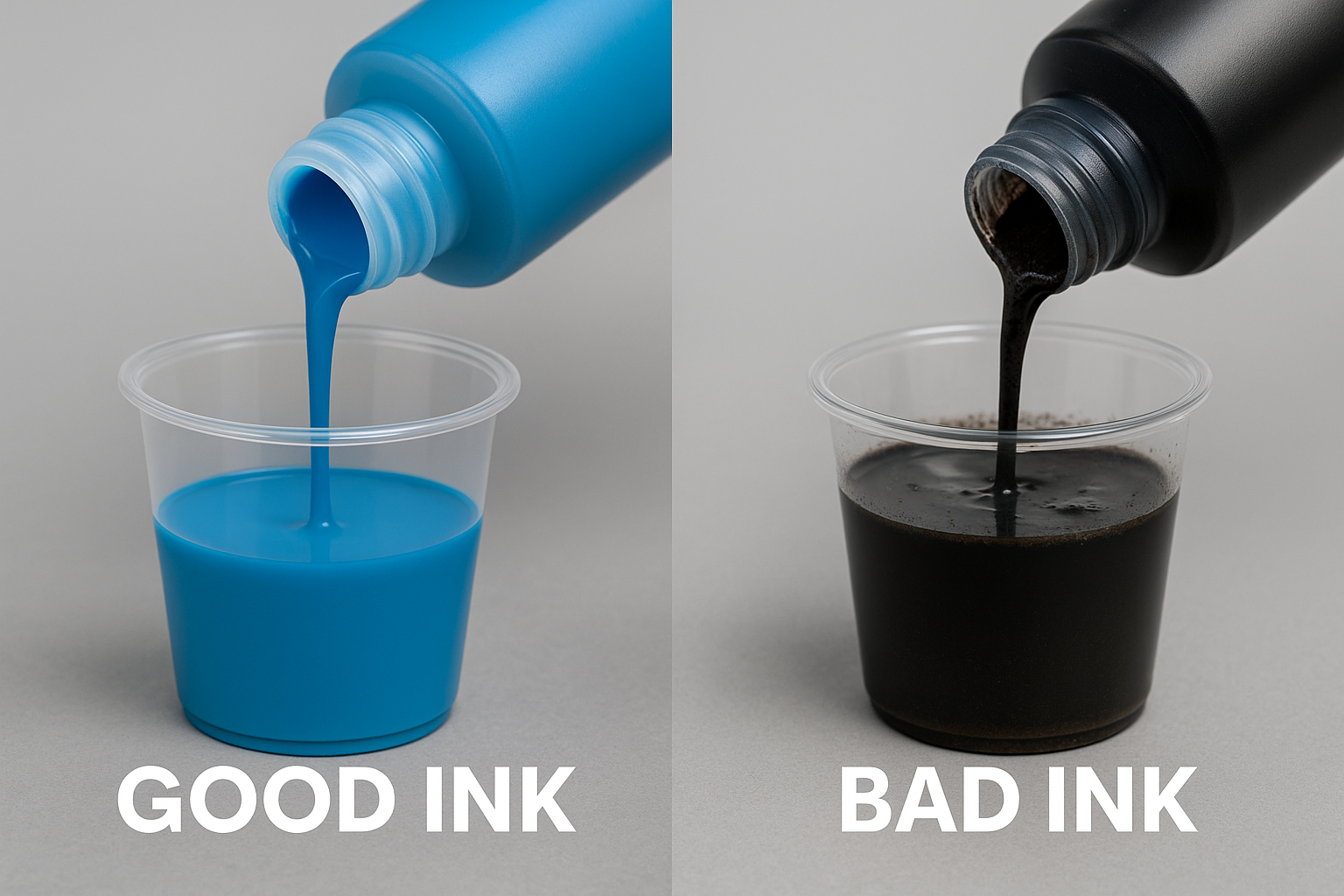
Ink expiry and printer warranty
We touched on this earlier, but it bears repeating: using inks beyond their expiry can affect your printer’s warranty. All the major printer manufacturers (Roland DG, Epson, Brother, etc.) specify that you must use their products as recommended. This includes using genuine inks and replacing them as advised.
If a printer issue is traced back to expired or improperly stored ink, the manufacturer may refuse a warranty claim on the basis of misuse. In most cases, they consider expired ink similar to using the wrong type of ink or a third-party product – it wasn’t part of the intended spec, so any damage it causes is not their responsibility.
In short, following ink use-by dates isn’t just about print quality, it’s about protecting your investment. These printers are sophisticated devices, and the ink is its lifeblood. Fresh, in-spec ink keeps everything running happily.
Best practices to manage your ink shelf life
To wrap up, here are some practical tips to ensure you never get caught out with expired ink and that you maximise the value of the ink you buy:
- Track your inventory: Keep an eye on the dates of the ink cartridges you have in storage. It can be as simple as marking the expiry month on the outside of a box with a marker or maintaining a small log. Order your stock such that the oldest is front and centre to be used next.
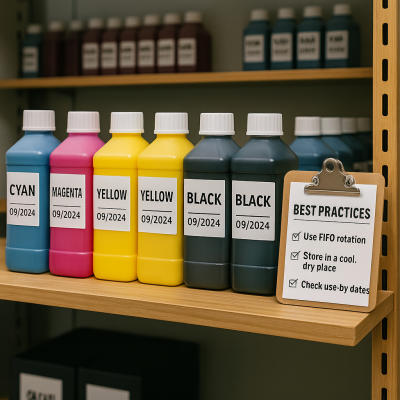
- Store inks properly: Almost all inks prefer a cool, dry, dark environment. Avoid extreme temperatures, both heat and freezing cold can spoil ink. Keep cartridges in their sealed packaging until you need them; the packaging is designed to keep air and light out. Store them upright (especially important for cartridges that have sponges or ones that feed from the bottom) to keep the ink in the right place and pigment evenly distributed.
- Use your printer regularly: Ink sitting idle in the machine can expire in a different way, by drying out. Many modern printers do mini cleaning cycles or circulate ink to prevent sedimentation, but if you leave a printer unused for months, the ink in the lines and head can start drying or settling even if the cartridge itself is not expired.
- Follow manufacturer guidelines: Different printers have different maintenance requirements. For example, some white ink systems have automatic agitation mechanisms; make sure those are enabled. Some printers might recommend replacing a cartridge after 6 months of use even if it’s not empty (some Epson models have this note for reliability). It’s a good idea to adhere to those, as they’ve been determined based on extensive testing.
- When in doubt, ask: If you’re ever unsure about the status of an ink or whether it’s safe to use, reach out to us. It’s better to spend a few minutes getting advice than to push your luck and regret it. We’re here to help our customers make the best choices for their printers and printing business.
In summary, ink use-by dates are very important to follow. They ensure that the ink you use is in peak condition, giving you vibrant prints, smooth printer operation, and peace of mind. With potentially long supply chains to Australia and different shelf lives for different ink types, being mindful of dates and storage conditions will save you from headaches.
Using an expired ink cartridge to the last drop might feel like you’re getting your money’s worth, but it only takes one clog or printer failure to wipe out any savings and then some. Keep your ink fresh, and your printer will thank you with better performance and reliability. By following these guidelines, you’ll reduce support issues and downtime, and you’ll consistently deliver the quality prints that you and your customers expect. Happy printing!
About the Author

About GJS
GJS is Australia’s premier provider of solutions and services for the textile, promotional products, custom photo gift, sign and display industries. With over 46 years’ experience, GJS supplies everything needed to start and operate a successful printing business including equipment, consumables, training and support. Headquartered in Revesby, NSW, and with additional teams located in Victoria and Queensland, GJS serves customers throughout Australia, New Zealand, and the Pacific Islands. For more information visit: gjs.co. GJS and the GJS logo are trademarks or registered trademarks of GJS. Other names are trademarks of their respective owners.
